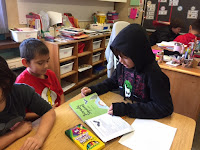
Each grade 3 student was partnered with a grade 7 student and they spent the first 20 - 30 minutes reading and sharing their books.
Next the grade 7 students interviewed the grade threes and helped them put together a plan for their game including the artwork for their sprites. Some of the artwork was drawn completely by the grade three students, while in other cases, the grade 7 students took on the role of artist, guided by suggestions given by the grade three clients.
It was really interesting to see the discussion taking place in the classroom. Everyone was on task and engaged.
 Both classroom teachers noticed the depth of engagement with students who typically struggled with focus. I had originally feared that the the discussion would be somewhat scripted and based on the interview worksheet that the sevens had prepared, but instead I noticed a lot of authentic discussion regarding game development.
Both classroom teachers noticed the depth of engagement with students who typically struggled with focus. I had originally feared that the the discussion would be somewhat scripted and based on the interview worksheet that the sevens had prepared, but instead I noticed a lot of authentic discussion regarding game development. I noticed in some discussions the very nuanced ability to steer the discussion in very productive ways. Because the grade 7 students had already spent some time coding, they knew the limits of their abilities and were able to steer and re shape grandiose plans into goals that were reachable.
Below is one such discussion.It is a little hard to hear due to all of the talk occurring in the classroom at the time, but their body language shows the dept of their engagement.
More Photos:















